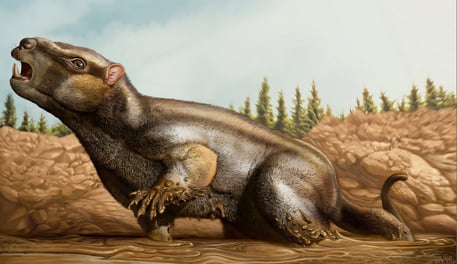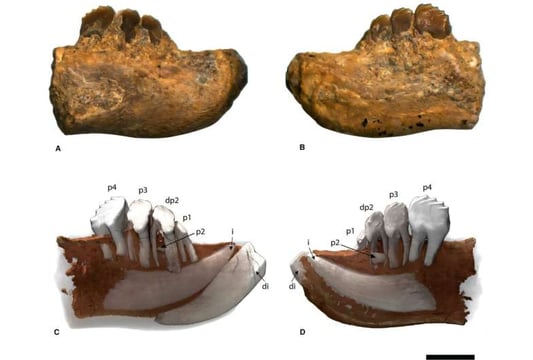Scientists Discover New Mammalian Fossil with an Unusual Tooth Pattern
Anurag Maurya
5/3/20253 min read


A remarkable fossil discovery in Portugal is reshaping what we know about early mammalian evolution. Paleontologists have uncovered a new species of multituberculate mammal—Cambelodon torreensis—from the Upper Jurassic Freixial Formation, offering critical insight into the diversity and adaptability of ancient mammals.
This new species belongs to Pinheirodontidae, an extinct family of multituberculates—an early and successful group of mammals that thrived for nearly 100 million years before the rise of modern mammals. The research, recently published in Papers in Palaeontology, reveals unique features in the jaw and teeth of this juvenile specimen, providing tantalizing clues about developmental biology and evolutionary pathways.
A Unique Tooth Replacement Pattern
What sets Cambelodon torreensis apart is its non-sequential tooth replacement—a rare and previously undocumented pattern in multituberculates. Unlike the typical posteroanterior tooth replacement (where teeth are replaced from the back to the front), C. torreensis exhibits irregular replacement, meaning that its deciduous and permanent teeth did not follow a consistent replacement order.
According to Victor Carvalho, lead author of the study,
“This pattern is exceptionally rare, which makes it challenging to study in depth.”
This finding challenges long-held assumptions about tooth development in extinct mammals and suggests alternative growth strategies may have existed—possibly influenced by dietary or ecological factors. This deviation opens new research frontiers into the developmental biology of early mammals and how they adapted to their environments over evolutionary time.
🌍 Portugal’s Rich Multituberculate Fossil Record
Europe, particularly Portugal, plays a pivotal role in understanding multituberculate evolution. The Guimarota coal mine, one of the most fossil-rich Jurassic sites, has yielded a diverse assemblage of multituberculates, shedding light on their evolutionary history and ecological diversity.
“These fossils provide compelling evidence that multituberculates were evolving rapidly and continuously, showcasing their adaptive flexibility over time.”
The fossil record from Portugal demonstrates how multituberculates adapted to changing environments over millions of years, surviving alongside dinosaurs and paving the way for modern mammals.
🔍 A Glimpse into a Complex Lineage
The lower jaw fossil of C. torreensis, cataloged as SHN.830, showed intriguing similarities to various multituberculate families such as paulchoffatiids, plagiaulacids, allodontids, and pinheirodontids, yet none matched exactly. This specimen displayed distinctive traits:
Large triangular lobes
Five projections on premolars (p3 and p4)
Nine basal cusps on p4
These unique features suggest that C. torreensis may represent a transitional or highly specialized form, highlighting the complexity and variability within multituberculates.
🦴 What's Next? The Search for Postcranial Evidence
Despite the excitement surrounding the jaw fossil, researchers are still hunting for associated postcranial remains to build a complete anatomical profile. Some bones from Guimarota may belong to multituberculates, but further analysis is needed to confirm any connection to C. torreensis.
This knowledge gap underlines the difficulty of reconstructing the full physiology of extinct species—but also emphasizes the importance of each new discovery in deepening our understanding of mammalian ancestry.
🧠 Conclusion: A Step Forward in Mammalian Evolution
The discovery of Cambelodon torreensis offers a rare window into the life and biology of mammals during the age of dinosaurs. With its unusual tooth pattern and morphological traits, this species challenges existing theories and opens new avenues for research into early mammalian evolution.
As paleontologists continue to unearth the secrets of our ancient ancestors, discoveries like this remind us of the complexity and resilience of life on Earth—and how much there is still to learn.
📚 Reference:
Carvalho, V. M. et al. (2025). A new pinheirodontid multituberculate with an unusual tooth replacement pattern from the Upper Jurassic of Portugal. Papers in Palaeontology.


Cambelodon torreensis becoming entrapped in the Ulsa Quarry. Credit: Victor Carvalho in Carvalho et al. 2025
A) The image shows a fossil jawbone (SHN.830) from both outer (lateral) and inner (medial) sides. B) 3D model showing unerrupted incisor. Scale bar is 2 mm. Credit: Carvalho et al. 2025
email: science@geoprimex.com
© 2024. All rights reserved.
Whatsapp: +919044995188
Contact Informaton
Important links
anuragmaurya80@gmail.com
